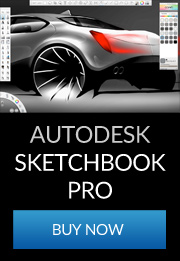Archives for :
January2010
Aerodynamic factors, considered carefully, can improve many aspects of a vehicle. Some key aerodynamic considerations have been summarised here.
[(vi) refers to Road Vehicle Aerodynamic Design by R.H. Barnard]
With an object moving through a fluid, the wake is extremely significant. When considering family vehicles, the nature of the vehicle’s rear, in three dimensions, can make the difference between a low or a high coefficient of drag (Cd).
Improvements at the front can be made by ensuring the ‘front end is made as a smooth, continuous curve originating from the line of the front bumper’. On normal two and three box shapes, drag is often caused by high pressure just upstream of the front windscreen, ‘often with a separation bubble of recirculating air at the base of the screen’. The magnitude of this effect depends upon the windscreen ‘rake angle’. Making the screen more raked (ie. not as upright) ‘tends to reduce the pressure at the base of the screen, and to lower the drag’. However, much of this improvement arrives because a more sloped screen means a softer angle at the top where it meets the roof, keeping flow attached. Similar results can be achieved through a suitably curved roof.
Design in plan as well as profile, is significant. ‘Curving the windscreen in plan view modifies the flow patterns considerably … which reduces the extent and intensity of high pressure.’
The A-post is also an issue: ‘A strong outward cross-flow can occur towards the edges of the windscreen, tending to produce separated vortices around the A-posts.’ These effects can be minimised by smoothing the form of the A-post and increasing the curvature of both the A-post and the screen. Smoothing the transition from the body to door mirror is also significant as it can otherwise be a major source of drag and wind noise.
At the rear of vehicles, the ideal format is a long and gradual slope. As this is not practical, it has been found that ‘raising and/or lengthening the boot generally reduces the dragâ€.
Results of research state that drag due to rear slope angle will be at its ‘peak at 30º and minimum at around 10º’.
Increasing the curvature of the roofline will also reduce the drag coefficient. Benefits are gained by bringing the roof line down at the front and rear. Simply ‘bulging the roofline up’ however, may cause such an increase in frontal area that any gains may be negated.
In plan view, rounding corners and ‘all forward facing elements’ will reduce drag. Increases in curvature of the entire vehicle in plan will usually decrease drag provided that frontal area is not increased. ‘Tapering the rear in plan view’, usually from the rear wheel arch backwards, ‘can produce a significant reduction in drag’. Under the vehicle, a smooth surface is desirable as it can reduce both vehicle drag and surface friction drag. ‘For a body in moderate proximity to the ground, the ideal shape would have some curvature on the underside.’
In (vi), the author lists the following significant areas for thought when attempting to design a typical car (not a sports car or commercial vehicle):
- Smooth unbroken contours with favourable pressure gradients as far back as practical should be used.
- Strongly unfavourable pressure gradients at the rear should be avoided; some taper and rear end rounding should be used.
- The form should produce negligible lift.
A If a hatchback configuration is required, the backlight angle should not be in the region of 30º, and if a notchback (saloon) is to be used, the effective slope angle (ie. the angle of a direct line between the roof and the highest, most rearward point) should also not be in the region of 30º.
- The underbody should be as smooth and continuous as possible, and should sweep up slightly at the rear,
- There should be no sharp angles (except where it is necessary to avoid cross-wind instability).
- The front end should start at a low stagnation line, and curve up in a continuous line.
- The front screen should be raked as much as is practical.
- All body panels should have a minimal gap.
- Glazing should be flush with the surface as much as possible.
- All details such as door handles should be smoothly integrated within the contours.
- Excrescences should be avoided as far as possible; windscreen wipers should park out of the airflow.
- Minor items such as wheel trims and wing mirrors should be optimised using wind-tunnel testing.
- The cooling system needs to be designed for low drag.
Although aerodynamic concerns are not as strong in this vehicle as they may be in a sports car, for example, the basic principles outlined here should be observed throughout the design process. Energy efficiency can be improved with low drag and low levels of wind noise improve passenger comfort.
 |
| Image courtesy & © Ford Motor Company |
Aerodynamics is a highly refined science that vies for position with other key vehicle design considerations such as styling and ergonomics. It’s importance with respect to the operating efficiencies of a vehicle is undisputed but manufacturers must steer a balanced path between the push an pull of the many other aspects of a car necessary to sell it to the consumer.
Aerodynamics started life as much as an art as a science. Early experiments used fish as the inspiration. Their sleek form was considered important to facilitate fast movement, but the precise details were not yet understood and developments were largely based on trial and error. It was as a result of this approach that the ‘teardrop’ form was conceived.
 Aerodynamic Considerations
Aerodynamic Considerations
A summary of key principles and basic rules to follow in order to improve aerodynamic efficiency when designing a vehicle.
 |
 |
 |
| Pressure Sensitive Paint | Aerodynamic work on the 1960s Ford GT programme | Wind tunnel testing for modern vehicles |
Welcome to the design section of Car Design Online. This area includes information on most of the pre-production elements of automotive design. These include the creative elements of vehicle development, such as sketching and modelling, as well as other important considerations, namely aerodynamics and ergonomics.
Aerodynamics
In this section we take a look at the science of aerodynamics and how manufacturers use CAD and wind-tunnel testing to perfect new vehicles.
Ergonomics
An increasingly important aspect of automotive design, this section on ergonomics and anthropometrics looks at design for human form and behaviour.
Modelling
Whether virtual or actual, realising a design in 3D has always been a critical element of vehicle development. From clay to CAD, we look at the different methods and practices.
Sketching
From a designer’s initial idea to fully resolved renderings; we take a look at how ideas are realised in 2D.
With ever increasing demands for refinement in vehicle design, new methods are developed to provide a greater level of detailed information. Special pressure sensitive paint is now used in the wind tunnel to graphically show levels of air pressure on a vehicle.
The Process
Two different images are obtained, one at normal room air pressure (wind-off) and a second in which the wind tunnel is running (wind-on) at a desired test speed. These differences in color, from wind-off to wind-on, are used to calculate surface pressure.


A bank of blue lights illuminate a 2002 Ford Thunderbird that has pressure-sensitive paint applied on the driver’s side window. The car and lights are in a wind tunnel at Ford Motor Company’s Dearborn Proving Ground. Ford researchers have developed a computerized, pressure-sensitive paint technique that measures airflow over cars, shaving weeks off current testing methods. A digital camera near the blue lights captures this information and feeds it into a computer, which displays the varying pressure as dramatically different colours on a monitor.


The images obtained from tests in the wind tunnel are captured on computer. They can then be used to study air flow patterns across a vehicle, highlighting areas of possible refinement or improvement. Additionally, actual data from a production ready model can be compared with pre-production computer predictions which can in turn help improve the accuracy of the early design stages.

